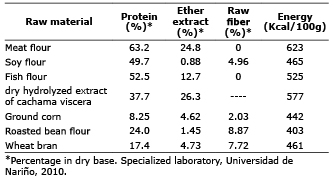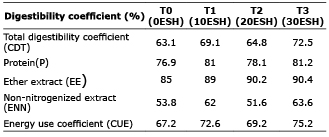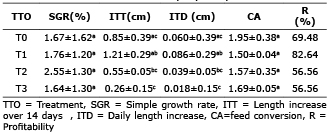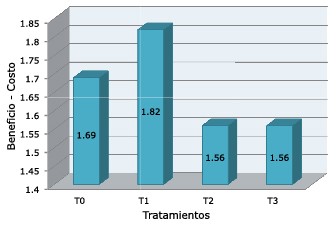Services on Demand
Journal
Article
Indicators
-
 Cited by SciELO
Cited by SciELO -
 Access statistics
Access statistics
Related links
-
 Cited by Google
Cited by Google -
 Similars in
SciELO
Similars in
SciELO -
 Similars in Google
Similars in Google
Share
Revista MVZ Córdoba
Print version ISSN 0122-0268
Rev.MVZ Cordoba vol.21 no.1 Córdoba Jan./Apr. 2016
ORIGINAL
Digestibility of diets with flour fish silage for the growing of arawana (Osteoglossum bicirrhossum)
Digestibilidad de dietas con harina de hidrolizado de pescado, para el levante de arawana (Osteoglossum bicirrhossum)
Mario Paz A,1 Ing, John Meneses R,1 Ing, Jorge López M,1* Ph.D.
1Universidad de Nariño, Faculty of Fish Sciences, Department of Hydrobiological Resources, Calle 18 Cr. 50. Ciudad Universitaria Torobajo, San Juan de Pasto, Colombia.
*Correspondence: jorgelopezmacias@gmail.com
Received: May 2014; Accepted: June 2015.
ABSTRACT
Objective. The purpose of this research was to evaluate the digestibility of different nutritional and energy components of artificial diets containing flour fishsilage used in growing of arawana fingerlings (O. bicirrhossum). Materials and methods. 240 fingerlings distributed in 12 tanks with 20 fish per experimental unit were handled, in a completely randomized design made up of 4 treatments with three replicates, each with inclusions of 0 (0ESH), 10 (10ESH), 20(20ESH) and 30% flour fish silage (30ESH) of treatments T0, T1, T2 and T3 respectively; fromflour fish silagein order to formulate isoenergetic and isonitrogenous diets in the different treatments to avoid sources of miscalculation of the experimental variables. Results. High digestibility coefficients were observed in treatments T1 (10ESH) and T3 (30ESH). The protein, lipid and energy utilization ratios were greater than 60%, which shows the importance of including flour fish silage as a source of protein to improve the various growth parameters. Significant differences between treatments were found in the increase of length (p≤0.05), showing that the T1 was the best treatment with an average of 1.21±0.29 cm. Conclusions. According to the coefficients of digestibility, length increase and benefit - cost ratio, the best treatment was T1 (10ESH) used to feed arawana (O. bicirrhossum), during the growing period, demonstrating the economic and ecological advantages for utilization of this source of protein in aquaculture.
Key words: Aquaculture, diets, fish silage, nutrition, protein, silver arawana (Sources: MeSH, FAO).
RESUMEN
Objetivo. Analizar la digestibilidad de los diferentes componentes nutricionales y energéticos en dietas balanceadas con niveles de harina de hidrolizado de vísceras de cachama en el alevinaje de arawana (O. bicirrhossum). Materiales y métodos. Se evaluaron 240 alevinos, distribuidos en 12 acuarios a razón de 1 animal/5 L. Se utilizó un diseño completamente al azar, conformado por cuatro tratamientos con tres réplicas cada uno, con inclusiones de 0 (0ESH), 10 (10ESH), 20 (20ESH) y 30% de extracto seco de hidrolizado de vísceras de cachama (30ESH) para los tratamientos T0, T1, T2 y T3 respectivamente; para evitar fuentes de error en el cálculo de las variables experimentales, se formularon dietas isoenergéticas e isonitrogenadas. Resultados. Se detectaron diferencias estadísticas significativas en el incremento de longitud (p≤0.05), indicando que el T1 (10ESH) es el mejor tratamiento con un promedio de talla de 1.21 ±0.29 cm, además, se obtuvieron coeficientes de digestibilidad superiores al 60% en los tratamientos T1 (10ESH) y T3 (30ESH) en lo referente a proteína, lípidos y Coeficientes de Utilización Energética (CUE); demostrando la importancia de incluir el extracto seco de hidrolizado de vísceras de cachama, en las dietas de los peces para mejorar las distintas variables zootécnicas, teniendo en cuenta la importancia acuariofílica de la especie. Conclusiones. De acuerdo con los coeficientes de digestibilidad, incrementos de longitud y la relación beneficio - costo el mejor tratamiento fue el T1 (10 ESH) en dietas de levante para O. bicirrhossum; demostrando las ventajas económicas y ecológicas de la incorporación de esta materia prima en la alimentación acuícola.
Palabras clave: Acuacultura, arawana plateada, dietas, ensilado, nutrición, proteína. (Fuentes: DeCS, FAO).
INTRODUCTION
The silver arawana (O. bicirrhossum) is a fish species that inhabits the Amazon River and its tributaries: Putumayo, Caquetá and Orinoco (1). It is characterized as having high commercial value in cultivation destined for human consumption and sport fishing due to their shape and color that make them appealing and attractive to the fish market. This has resulted in the species being listed in the Red Book for freshwater fish, considered endangered (2).
Most aquaculture feeding trials have been conducted without establishing digestibility coefficients for the diets, which means that the nutritional benefits of one material in comparison with others cannot really be determined. For this reason, one of the most important aspects in assessing the effectiveness of feed is understanding the rate of assimilation that quantifies the ability of the fish to digest and absorb nutrients from its diet. This is essential to formulate practical fish feed diets based on determining nutritional requirements, which in turn are related to the content of digestible nutrients. A diet's digestibility depends on the age of the animal, its physiology, the physic-chemical and biological characteristics of water, the nutritional value of different types of raw materials and how the nutrients interact. In aquaculture production, 15% of the weight comes from viscera, which is removed and poured directly into water sources, thus creating pollution and spreading pathogens to captive and natural fish populations (3).
Techniques to properly dispose of offal that would increase rates of return should be evaluated and implemented to maintain the physicochemical and bacteriological quality of bodies of water and their use in manufacturing balanced diets for fish. Therefore, this study determined the digestibility coefficients to establish the quality of raw materials used in aquaculture production by using dry hydrolyzed cachama viscera in varying percentages and measuring its effect on the zootechnical parameters of simple growth rate, survival, feed conversion and increased size during the cultivation of silver arawana.
MATERIALS AND METHODS
Study site and installations. Field work was conducted on the “VAI” fish station of the Aquaculture Association of Caquetá (ACUICA), which is located in El Quebradón in the northeastern department of Caquetá, on the road to El Doncello, 65 kilometers from Florencia, at the following geo coordinates: 1° 40' 46” North and 75°16' 45” West, at 373 meters above sea level, average temperature 26°C and an average rainfall of 3200 mm/year in normal conditions (4). The evaluation was carried out in a greenhouse type system in which 12 100-liter aquariums were placed (90cm long by 30cm wide and 40 cm high). Each unit was equipped with a thermostat, ventilation system and filter to provide the appropriate conditions for the fish species studied.
Biological material and management. 500 silver Arawana were initially obtained with an average weight of 1.2±0.2 g., vitelinic larvae. The fish were transferred to the greenhouse where they were randomized into aquariums for a period of four months, three of which were devoted to cultivation and feed and one for study purposes.
The aquariums were kept at an average temperature of 30.2±1.6°C. The acclimation period lasted two weeks, during which labors such as siphoning, 90% daily water exchange, and recording of physicochemical parameters such as temperature and oxygen was done with a YSI 550A probe and pH with Hach equipment to keep the fish in optimal condition. After the yolk sac was absorbed, the fish were fed with commercial flakes with 48% protein for a month, which was gradually replaced with an extruded commercial diet of 45% (p/v) protein, supplied three times a day until the population reached an average standard length of 9.8 ± 0.9 cm. and an average weight of 6.6 ± 2.5 g. These values showed no statistical difference (p>0.05). Later, evaluation of experimental diets was initiated with 240 fish, establishing inclusions at 0 (OESH), 10 (10ESH), 20 (20ESH) and 30% dry hydrolyzed cachama viscera (Piaractus brachypomus) (30ESH) for T0, T1, T2 and T3 treatments respectively, with 20 animals per experimental unit and a daily supply of biomass at 6%, distributed in five meals a day.
Raw materials for the diet. The nutritional needs of native fish species grown in captivity can be met by providing artificial feed prepared with raw materials that have appropriate digestibility and palatability and that also meet the minimum nutritional requirements for the species under cultivation (3). To formulate the diets meat meal, soybean (Glycine max), fish, corn (Zea mays), wheat bran and bean flour (Phaseolus spp.) was used. Since one of the most expensive raw materials is fishmeal, this study proposed partially replacing this protein with hydrolyzed cachama viscera.
Preparing the hydrolyzed product and flour. The process took place in the laboratories of the Universidad de Nariño using 50 kg of cachama viscera which had the fat tissue and gastrointestinal contents removed. This raw material was ground to a homogeneous visceral paste and molasses, plain yogurt and potassium sorbate (Sigma-Aldrich, St. Louis, MO) were added in amounts of 15, 3 and 0.2% respectively (5). This was stored in glass and plastic containers for a ripening time of 216 hours during which it reached a pH of 4.10±0.07, optimal for inhibiting the growth of pathogens that could affect the product (6). This process was done in an incubator (Memmert, Schwabach, Germany) at a temperature of 38±2°C.
The ripe hydrolyzed product was transferred to a Styrofoam cooler to keep it isolated from moisture and sunlight, maintaining the pH range specified above. The average amount per container did not exceed 60% of the total volume to leave room for gas production due to fermentation; once hydrolysis was established and pH stability achieved, the flour was made by drying the mixture; the hydrolyzed product was poured into stainless steel trays in 4 mm layers and was dried at a temperature of 60°C in an oven (Memmert, Schwabach, Germany) for 14 hours to obtain a hard paste, and then was put through a micro mill (IKA, Staufen, Germany) to produce flour.
Bromatologic analysis of ingredients, preparation and balancing the diets. Each selected raw material was milled and sieved to a particle size of 450 microns to facilitate homogenization, and a proximal and energy analysis was performed following the Weende methodology as applied by specialized laboratories at the University of Nariño (Table 1). Isonitrogenous and isocaloric diets were obtained using the commercial program Feedsoft Enterprise (2010) and the Excel Solver (2010) tool using protein levels of not less than 45% and energy that did not exceed 5270 Kcal/kg, as well as the limited use of some ingredients according to sales costs, digestibility and what is recommended by Vazquez (7).
Table 1. Approximate analysis (%) and gross energy of the ingredients in different diets prepared with the dry hydrolyzed extract of cachama viscera.

Each diet was supplemented with 0.3% commercial mineral and vitamin premix for fish (DSM Nutritional Products, Bogotá, Colombia); Fish oil was also added at 3% carboxymethyl cellulose (CMC) at 1% to provide fiber and a binder and as a digestibility marker chromic oxide (Cr2O3) (Carlo Erba, Sabadell, Barcelona) at 0.9%.
To develop treatments they first weighed and mixed the flour and then the micro-ingredients until the greatest possible homogenization was achieved. Each treatment was moistened with 25% water and then the mixture was passed through a sieve with one millimeter mesh. The extruding process was done at the Laboratory of Aquatic Nutrition, Unit for Food Processing at the National Universidad de Colombia using a laboratory micro-extruder (Exteec, Vila, Brazil) to obtain 5mm granules that were then allowed to dry for 24 hours at 60°C and the fish oil was immediately added using a spray method.
Sample collection and analysis. They were collected five times daily; two in the morning and three in the afternoon in order to prevent leaching of fecal matter; during feeding and siphoning of the aquarium aeration was discontinued. Then they were stored in previously labeled plastic containers at an average temperature of -10°C. Feces were collected per aquarium to remove pollutants and were stored for treatment. The collection period lasted for 30 days until 50g of sample treatment was collected.
Proximate analysis of food and feces was made following the Weende methodology. Likewise, the amount of chromic oxide present in diets and feces was determined according to the Furukawa method (1993) adapted by the specialized laboratory at the University of Nariño, which involves adding 5 ml of concentrated nitric acid to 0.1 g of dry sample to digest for 45 minutes at 105°C, allowing it to cool and adding 0.5 ml of perchloric acid and then heating it to 220°C until chromium oxidation is seen in a change in color from green to orange; absorbance is then read at 350nm.
An economic analysis was done taking into account the fixed and variable costs of different experimental diets, searching for an alternative feed formula using cachama viscera produced by applying biological silage techniques to include it in the diet of silver arawana. The cost of arawana alevin were considered as well as the cost of raw materials, supplies and labor.
Experiment design. A completely random design (DCA) was used that consists of four treatments and three replicates per treatment, 20 per experimental unit for a total of 240 fish. Statistical assumptions were made to determine outliers, normality test (Chi-Square, Shapiro-Wilk) and homogeneity of variances (Bartlett, Levene). In the variance analysis (ANOVA) with variables that showed statistically significant differences (p<0.05) the Multiple Comparison Tukey test was applied in order to establish the best treatment. Regarding the results of digestibility, the values obtained for each treatment were determined keeping in mind that no statistical analysis was performed because the feces in different replicas were homogenized. Digestibility was calculated according to the following formulas: (8).
Digestibility variables
Total digestibility coefficient:
DT= 100 - 100 * [%Cr2O3 AL/%Cr2O3 H],
Where:
%Cr2O3 AL: amount of Cr2O3 in feed
%Cr2O3 H: amount of Cr2O3 in feces
Digestibility coefficient.
CD = 100 - [(%Cr2O3AL/%Cr2O3H) * (%NH/%NAL) * 100],
Where:
%Cr2O3 AL: amount of Cr2O3 in feed
%Cr2O3 H: amount of Cr2O3 in feces
%NH: amount of nutrients in feces
%NAL: amount of nutrients in feed
Energy use coefficient.
CUE = 100 - [(%Cr2O3AL/%Cr2O3H) * (%EBH/%EBA) * 100],
Where:
%Cr2O3 AL: amount of Cr2O3 in feed
%Cr2O3 H: amount of Cr2O3 in feces
%EBH: brute energy in feces
%EBA: brute energy in feed
Digestible energy.
ED = [CUE*EBA)/100],
Where:
CUE: coefficient of energy utilization
EBA: Brute Feed Energy
The productive variables were calculated as follows:
Productive variables
Increase in biomass.
IB = [BF - BI],
Where:
BF: final biomass
BI: initial biomass
Simple growth rate.
SGR = [(ln PF - ln PI)/t * 100],
Where:
PF: final weight
PI: initial weight
t: sample period
Size increase.
IT = [TF - TI],
Where:
TF: final size
TI: initial size
Feed conversion.
CA = [AC/IP],
Where:
AC: consumed feed
IP: weight increase
Survival.
S = [(NF/NI) * 100],
Where:
NF: number of animals at the end
NI: number of animals at the beginning
Analysis of benefit-cost relationship.
B/C = [(UB/TE) * 100],
Where:
UB: brute utility
TE: total expenditure
RESULTS
The experimental diets were balanced according to the quantities of different raw materials as shown in table 2 and were incorporated to ensure the isonitrogenous and isocaloric conditions of the diets for further evaluation.
Table 2. Percentage of each raw material to be included per 100g of feed for each treatment including dry hydrolyzed viscera.

The greatest values for digestibility, protein, fat and energy utilization coefficients were found in treatment T3 (30 ESH) with a value of 72.5 (Table 3). It is important to highlight that treatments that incorporated hydrolyzed viscera (ESH) at levels of 10 (T1), 20 (T2) and 30 (T3)% digestibility had digestibility percentages greater than 6, 1.7 and 9.4% of the total relative digestibility in relation to control treatment T0 (0 ESH) that consisted of a balanced diet without dry hydrolyzed product.
Table 3. Digestibility coefficient (%) of protein, ether extract, non-nitrogenized extract and energy utilization coefficient of diets prepared with dry hydrolyzed viscera.

The results of productive variables during 14 days of evaluation establish significant differences in apparent food consumption (p≤0.05), which indicates improved palatability in T0 and T2. Treatments T1 and T3 did not differ significantly according to the Tukey test (p≤0.05), as shown in figure 1.

Figure 1. Apparent consumption of dry extract of viscera hydrolyzed product in the different treatments.
The simple average growth rate (SGR) for silver arawana alevin had increases above 0.09 and 0.88% for T1 (10 ESH) and T2 (20ESH) treatments respectively when compared to control treatment T0 (0ESH) (Table 4). The analysis of variance (p≤0.05) for the increased average length of the different treatments detected statistically significant differences. The Tukey significance test indicated that T1 (10 ESH) recorded the greatest increases, averaging 1.21±0.29 cm, and the lowest value recorded for this variable was T3 (30 ESH) with 0.26±0.15 cm (Figure 2).
Table 4. Results of productive variables in the different treatments with dry hydrolyzed viscera.


Figure 2. Increased standard length in the different treatments with dry viscera hydrolyzed product.
Regarding the apparent feed conversion, it was found that there are no statistically significant differences between the averages of the different treatments (p>0.05); (Table 4).
Survival during the experiment was 100% for the four treatments. They were greatly tolerant of manipulation and stress caused by cleaning routines, changes, fecal collection and uneaten food removal as well as census for biometric records. According to the analysis of variance (p> 0.05), the physical and chemical parameters of water were similar in all treatments during the study period, and are within the ranges required for cultivating silver arawana (Table 5).
Table 5. Average physicochemical parameters in the different treatments.

The cost-benefit estimate shows that all treatments are economically viable; T1 (10 ESH) showed a ratio of 1.82, T0 (0 ESH) 1.69, and treatments T2 (20 ESH) and T3 (30 ESH) 1.56 (Table 3, Figure 3).

Figure 3. Cost benefit relationship per treatment.
DISCUSSION
Research confirms that the use of highly digestible raw materials in fish diets improves feed conversion, increases growth rates and reduces negative environmental impacts generated by the nitrogen and phosphorus waste from disposing of viscera in water bodies (9). Also, it was found that protein digestibility, ether extract and energy for the different treatments showed values higher than 60%, ensuring remodeling processes and cell growth and demonstrating the nutritional quality of the diets represented in the content of essential amino acids, the interaction of nutrients, and the soluble and water-soluble vitamins and minerals found in hydrolyzed cachama viscera (3).
Percentage values of digestibility of ether extracts in T1 (10 ESH), T2 (20 ESH), and T3 (30ESH) exceed 85% due to the elevated composition of fatty acid in hydrolyzed fish viscera, particularly unsaturated Omega 3 and Omega 6 fatty acids that have multiple physiological functions related to growth and the immune system and record greater digestibility when compared with fats present in traditional products that are less digestible (10).
The increase in weight and height reported in this study are consistent with other studies that show that silver arawana alevin raised in captivity under similar conditions have increased in average weight between 0.15 g/day and 0.20 g/day (1). The best digestibility values and analysis of productive variables were found in treatments with dry hydrolyzed fish viscera due to the biological quality, amino acids, interaction of nutrients and the presence of nonspecific growth factors in this product (1). Also, similarities with other studies reported increases in daily size from 0.06 cm to 0.08 cm, which shows that diets that include dry hydrolyzed cachama viscera can produce growth up to 1.21 cm in two weeks in total length during the initial developmental phase, which is highly important for fish species that are of interest to the fish industry (12).
Feed conversion and feed intake in the different experimental diets did not have statistical differences, showing that the inclusion of different percentages of dry hydrolyzed viscera to feed arawana does not affect yield, keeping in mind that weight increases were also statistically similar in all treatments. In contrast, size was significant in Q1 relative to the other treatments, important for this important species to the fish industry (13).
The economic analysis has shown the feasibility of using dry extracts of hydrolyzed fish entrails or waste, using it as a partial substitute for fishmeal, an expensive raw material that is increasingly scarce on the market. Therefore, we recommend using this fish waste according to the methodology described in this study as an ecological and economic alternative to reduce production costs and prevent contamination of water sources.
The results of this study allow us to conclude that diets with dry hydrolyzed viscera between 10 and 30% (p/v) are adequately digestible and including them at 10% ensures good productive performance in cultivating arawana. We recommend including this raw material in fish feed as a protein source and as a substitute for commercial fish silage.
Acknowledgements
The Aquaculture Association of Caquetá (ACUICA) for funding this research, to the Universidad Nacional de Colombia, located in Bogota, for academic and logistical support of the Aquaculture Production Engineering program of the Universidad de Nariño and to all people who in one way or another contributed to this research.
REFERENCES
1. Hernández Olaya C, Gómez Ramírez E, Hurtado Giraldo, H. Estudio Preliminar del Levante de Juveniles de Arawana Plateada (Osteoglossum bicirrhosum) en Sistemas Cerrados de Recirculación. Revista Facultad de Ciencias Básicas 2010; 6(1):96-113. [ Links ]
2. Mancera N, Álvarez R. Comercio de Peces Ornamentales en Colombia. Acta Biológica Colombiana 2008; 13(1):23-51. [ Links ]
3. López Macías J. Nutrición y Alimentación Piscícola. Colombia: Editorial Universidad de Nariño; 2014. [ Links ]
4. Instituto de Hidrología, Meteorología y Estudios Ambientales (IDEAM). Centro de documentación, Visor Geográfico. Colombia: [en línea] 2012. [fecha de acceso 20 de abril 2012] URL disponible en: http://geoapps.ideam.gov.co:8080/geovisor/index.jsf. [ Links ]
5. Spanopoulos Hernández M, Ponce Palafox J, Barba Quintero G, Ruelas Inzunza J, Tiznado Contreras M, Hernández Gonzales C et al. Producción de ensilados biológicos a partir de desechos de pescado, del ahumado de atún aleta amarilla (Thunnus albacares) y del fileteado de tilapia (Oreochromis sp), para la alimentación de especies acuícolas. Revista Mexicana de Ingeniería Química 2010; 9(2):167-178. [ Links ]
6. Llanes J, Toledo J, Fernandez I, Lazo de la Vega J. Estudio del ensilado biológico de pescado como inóculo de bacterias lácticas en la conservación de desechos pesqueros. Redvet 2007; 8(9):1695-7504. [ Links ]
7. Vásquez Torres W. Principios de Nutrición Aplicada al Cultivo de Peces. Colombia: Universidad de los Llanos; 2004. [ Links ]
8. Silva J, Pereira M, Cavero B, Oliviera M. Digestibilidade aparente dos nutrientes e energia de ração suplementada com enzimas digestivas exógenas para juvenis de tambaqui (Colosssoma macropomum Cuvier, 1818). Acta Amaz 2007; 37(1):157-164. [ Links ]
9. Rueda W, Vásquez W, Gutiérrez M. Digestibilidad de fosforo y proteína de raciones suplementadas con fitasa en tilapia, Oreochromis sp. Orinoquia 2012; 16(1):20-29. [ Links ]
10. Llanes Iglesias J, Bórquez A, Toledo Pérez J, Lazo de la Vega J. Digestibilidad aparente de los ensilajes de residuos pesqueros en tilapias rojas (Oreochromis mossambicus y O. niloticus). Zootecnia Trop 2010; 28(4):499-505. [ Links ]
11. Gutiérrez Walter, Zaldívar Javier, Contreras Guadalupe. Coeficientes de digestibilidad aparente de harina de pescado peruana y maíz amarillo duro para Colossoma macropomum (Actinopterygii, characidae). Orinoquia 2012; 16(2):179-186. [ Links ]
12. Cuaical C, Vallejo E, Franco H, Sanguino W. Efecto de la densidad de siembra y la adición de ácido ascórbico en el cultivo de Osteoglossum bicirrhosum. Rev MVZ Córdoba 2013; 18(3):3799-3806. [ Links ]
13. Llanes Iglesias J, Toledo Pérez J, Lazo de la Vega J. Tecnología de producción de alimento semi-húmedo a base de ensilados de residuos pesqueros en la alimentación de tilapia roja (Oreochromis mossambicus x O. niloticus). Redvet 2007; 8(9):1695-7504. [ Links ]













